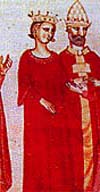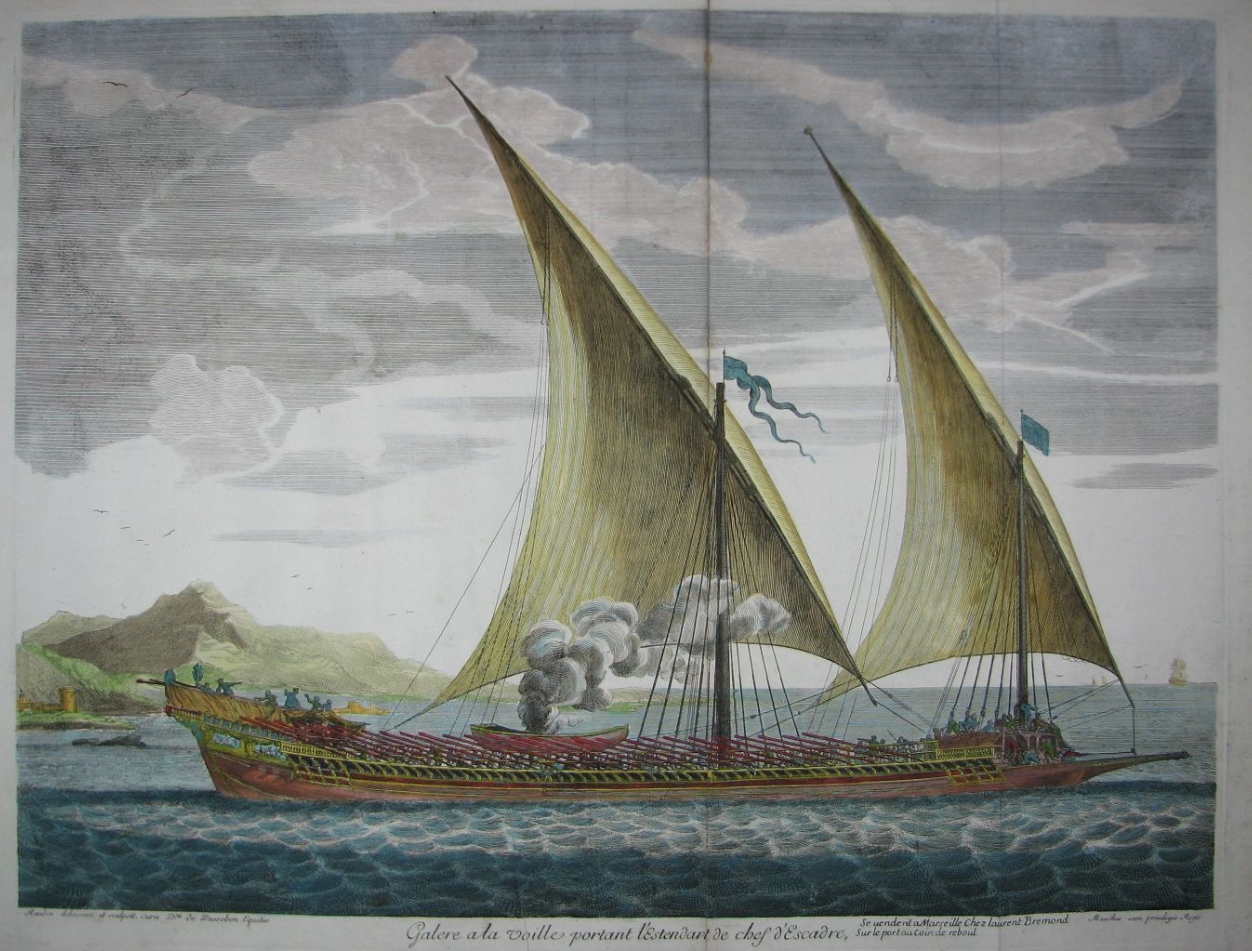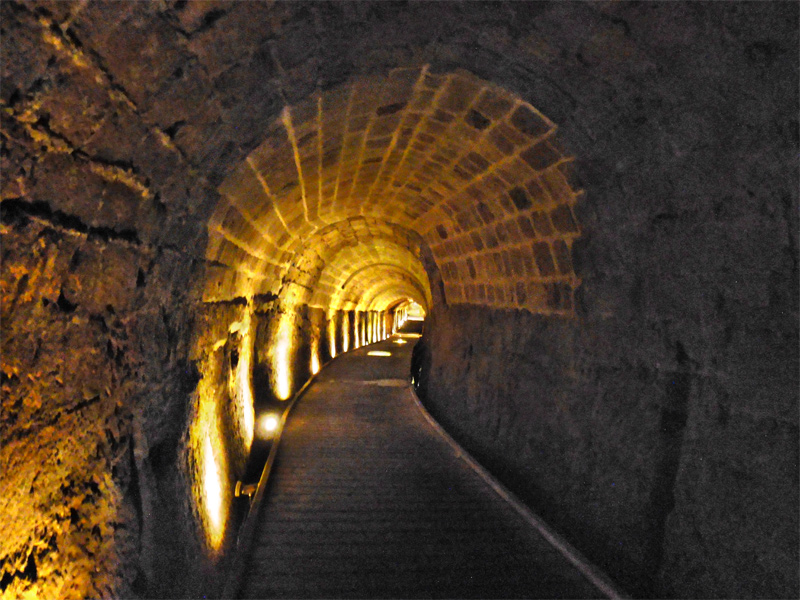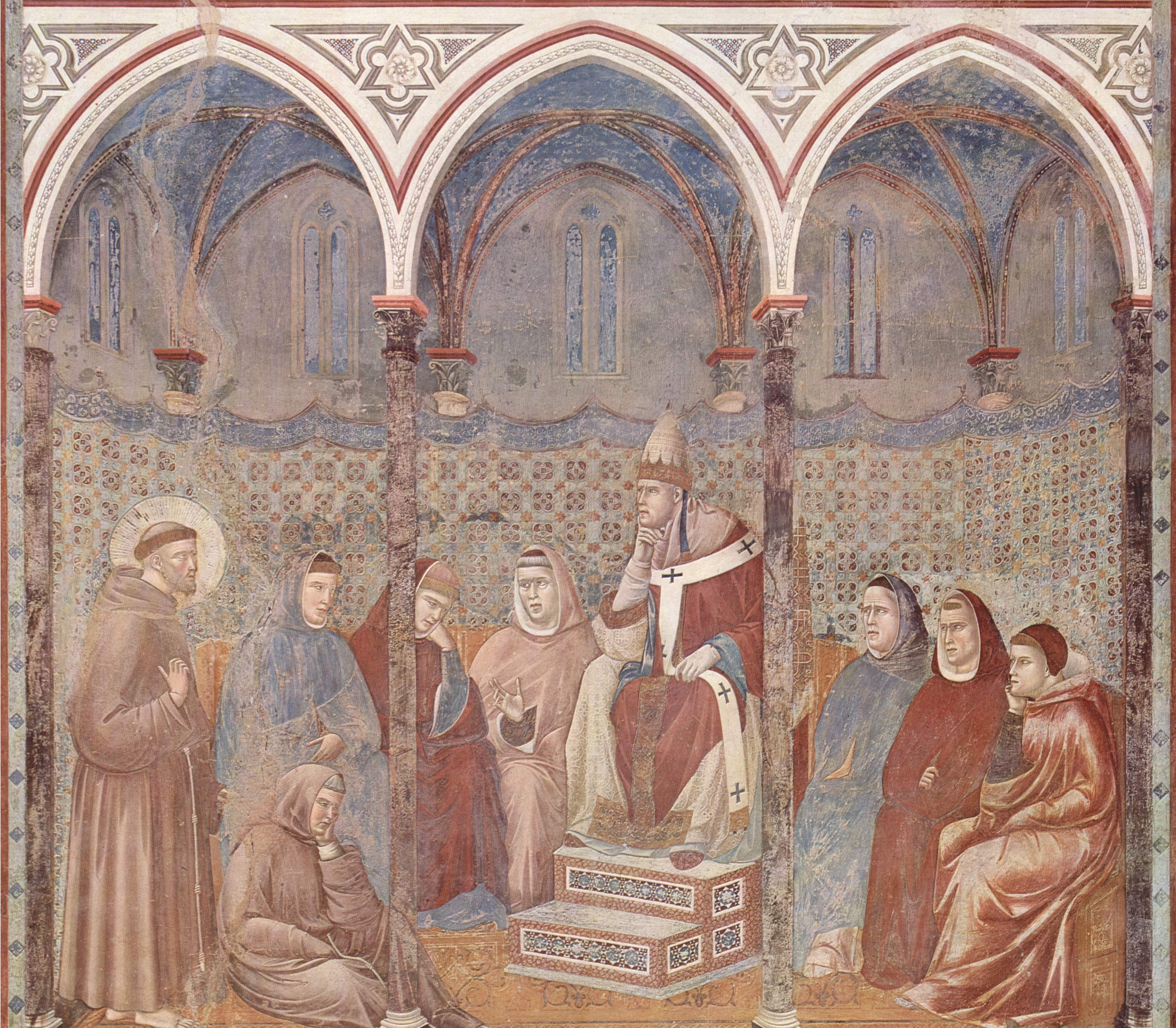|
Isabella II Of Jerusalem
Isabella II (12124 May 1228), sometimes erroneously called Yolanda, was Queen of Jerusalem from 1212 to 1228. She was the daughter of Queen Maria of Jerusalem and her husband, John of Brienne. By marriage to Frederick II, Holy Roman Emperor, Isabella also became Holy Roman Empress and Queen of Sicily and Germany. Infant Queen Isabella II was born in Andria, in the southern Italian Kingdom of Sicily. She was the only child of Maria of Montferrat, Queen of Jerusalem, and John of Brienne. Maria was the daughter of Queen Isabella I of Jerusalem by her second husband Conrad I, and heiress, on her mother's death, of the Kingdom of Jerusalem. Maria died shortly after giving birth to Isabella II in 1212, possibly by puerperal fever. Because of this, Isabella II was proclaimed Queen of Jerusalem when she was only a few days old. Because her father John did not have a direct claim on the throne, he ruled as regent. Marriage with Frederick II During a meeting between John of Brie ... [...More Info...] [...Related Items...] OR: [Wikipedia] [Google] [Baidu] |
Conrad Of Montferrat
Conrad of Montferrat (Italian language, Italian: ''Corrado del Monferrato''; Piedmontese language, Piedmontese: ''Conrà ëd Monfrà'') (c. 1146 – 28 April 1192) was a nobleman, one of the major participants in the Third Crusade. He was the ''de facto'' Kings of Jerusalem, King of Jerusalem (as Conrad I) by virtue of his marriage to Isabella I of Jerusalem from 24 November 1190, but officially elected only in 1192, days before his death. He was also the eighth List of rulers of Montferrat, Marquess of Montferrat from 1191. Early life Conrad was the second son of Marquess William V of Montferrat, "the Elder", and his wife Judith of Babenberg. He was a first cousin of Frederick I, Holy Roman Emperor, Frederick Barbarossa, Holy Roman Emperor, as well as Louis VII of France and Leopold V of Austria (Babenberg), Leopold V of Austria. Conrad was born in Montferrat, which is now a region of Piedmont, in northwest Italy; during the era in which he was born, it was a March of Montferra ... [...More Info...] [...Related Items...] OR: [Wikipedia] [Google] [Baidu] |
Palermo
Palermo ( ; ; , locally also or ) is a city in southern Italy, the capital (political), capital of both the autonomous area, autonomous region of Sicily and the Metropolitan City of Palermo, the city's surrounding metropolitan province. The city is noted for its history, culture, architecture and gastronomy, playing an important role throughout much of its existence; it is over 2,700 years old. Palermo is in the northwest of the island of Sicily, by the Gulf of Palermo in the Tyrrhenian Sea. The city was founded in Isla Palermo 734 BC by the Phoenicians as ("flower"). Palermo then became a possession of Ancient Carthage, Carthage. Two ancient Greeks, Greek ancient Greek colonization, colonies were established, known collectively as ; the Carthaginians used this name on their coins after the 5th centuryBC. As , the town became part of the Roman Republic and Roman Empire, Empire for over a thousand years. From 831 to 1072 the city was under History of Islam in south ... [...More Info...] [...Related Items...] OR: [Wikipedia] [Google] [Baidu] |
Brindisi
Brindisi ( ; ) is a city in the region of Apulia in southern Italy, the capital of the province of Brindisi, on the coast of the Adriatic Sea. Historically, the city has played an essential role in trade and culture due to its strategic position on the Italian Peninsula and its natural port on the Adriatic Sea. The city remains a major port for trade with the Balkan Peninsula, Greece and the Middle East. Its industries include agriculture, chemical works, and the generation of electricity. From September 1943 to February 1944, Brindisi was the provisional government seat of the Kingdom of Italy, meaning that the city has been one of the 5 capitals in the history of Italy. Etymology The name comes from the Latin , through the Greek , is a corruption of the Messapic language, Messapian , meaning "head of the deer", and probably referring to the shape of the natural harbour. It is related to Albanian language, Albanian bri, brî - pl. Brini zi (black horn) brirë, brinë ("horn"; " ... [...More Info...] [...Related Items...] OR: [Wikipedia] [Google] [Baidu] |
Galley
A galley is a type of ship optimised for propulsion by oars. Galleys were historically used for naval warfare, warfare, Maritime transport, trade, and piracy mostly in the seas surrounding Europe. It developed in the Mediterranean world during Classical antiquity, antiquity and continued to exist in various forms until the early 19th century. It typically had a long, slender hull, shallow draft (hull), draft, and often a low freeboard (nautical), freeboard. Most types of galleys also had sails that could be used in favourable winds, but they relied primarily on oars to move independently of winds and currents or in battle. The term "galley" originated from a Greek term for a small type of galley and came in use in English from about 1300. It has occasionally been used for unrelated vessels with similar military functions as galley but which were not Mediterranean in origin, such as medieval Scandinavian longships, 16th-century Ghali (ship), Acehnese ghalis and 18th-century North ... [...More Info...] [...Related Items...] OR: [Wikipedia] [Google] [Baidu] |
Riccardo Di San Germano
Richard of San Germano (; before 1170 – after October 1243) was a notary in San Germano in the Latin Valley not far from the monastery of Monte Cassino between February 1186 and March 1232. He wrote a chronicle (sometimes ''Chronica regni Siciliae'') of the Mezzogiorno from the death of William II of Sicily in 1189 to 1243. It is the fullest source of information on the Hohenstaufen in Italy. Richard was a companion of Stephen of Marsia, the abbot of Montecassino, and dedicated his chronicle to him. His brother John was also a notary, though in the chancery of Emperor Frederick II. In the early 1220s, Richard was found in the service of Frederick, perhaps alongside his brother. In the late 1230s, Richard became an imperial Chamberlain (until 1242). His chronicle was originally intended as a continuation of the '' Annales Casinenses''. It is largely, but far from mostly, focused on the ''Terra Sancti Benedicti'', the lands of the abbey of Montecassino. The first part was w ... [...More Info...] [...Related Items...] OR: [Wikipedia] [Google] [Baidu] |
Bishop Of Patti
The Diocese of Patti () is a Latin diocese of the Catholic Church located on the north shore of the island of Sicily. It is a suffragan of the Archdiocese of Messina-Lipari-Santa Lucia del Mela."Diocese of Patti" ''''. David M. Cheney. Retrieved February 29, 2016"Diocese of Patti" ''GCatholic.org''. Gabriel Chow. Retrieved February 29, 2016. Its patron saint is |
City Of Acre
Acre ( ), known in Hebrew as Akko (, ) and in Arabic as Akka (, ), is a city in the coastal plain region of the Northern District of Israel. The city occupies a strategic location, sitting in a natural harbour at the extremity of Haifa Bay on the coast of the Mediterranean's Levantine Sea."Old City of Acre." , World Heritage Center. World Heritage Convention. Web. 15 April 2013 Aside from coastal trading, it was an important waypoint on the region's coastal road and the road cutting inland along the Jezreel Valley. The first settlement d ... [...More Info...] [...Related Items...] OR: [Wikipedia] [Google] [Baidu] |
Proxy Marriage
A proxy wedding or proxy marriage is a wedding in which one or both of the individuals being united are not physically present, usually being represented instead by other persons (proxies). If both partners are absent, this is known as a double proxy wedding. Marriage by proxy is usually resorted to in one of two situations: either a couple wish to marry but one or both partners cannot attend (for reasons such as military service, imprisonment, or travel restrictions); or a couple lives in a jurisdiction in which they cannot legally marry. In most jurisdictions, the law requires that both parties to a marriage be physically present: proxy weddings are not recognized as legally binding. Under the English common law, however, if a proxy marriage is valid under the law of the place where the marriage was celebrated (the ''lex loci celebrationis'') then it will be recognised as valid in England and Wales. History Early Modern Starting in the Middle Ages, European monarchs and n ... [...More Info...] [...Related Items...] OR: [Wikipedia] [Google] [Baidu] |
Sixth Crusade
The Sixth Crusade (1228–1229), also known as the Crusade of Frederick II, was a military expedition to recapture Jerusalem and the rest of the Holy Land. It began seven years after the failure of the Fifth Crusade and involved very little actual fighting. The diplomatic maneuvering of the Holy Roman Emperor and King of Sicily, Frederick II, Holy Roman Emperor, Frederick II, resulted in the Kingdom of Jerusalem regaining some control over Jerusalem for much of the ensuing fifteen years as well as over other areas of the Holy Land. Western Europe after the Fifth Crusade The Fifth Crusade ended in 1221, having failed to gain any more influence in the Near East. Frederick II, Holy Roman Emperor, Frederick II, Holy Roman Emperor, never joined the campaign, despite his vow to do so. The forces he sent to Egypt arrived too late to make a difference in the debacle, partially due to the lack of effective leadership. They would have to wait for many more years for Frederick's actions. W ... [...More Info...] [...Related Items...] OR: [Wikipedia] [Google] [Baidu] |
Ferentino
Ferentino is a town and ''comune'' in Italy, in the province of Frosinone, Lazio, southeast of Rome. It is situated on a hill above sea level, in the Monti Ernici area. History ''Ferentinum'' was a town of the Hernici; it was captured from them by the Romans in 364 BC and took no part in the rising of 306 BC. The inhabitants became Roman citizens after 195 BC, and the place later became a municipium. It lay just above the Via Latina and, being a strong place, served for the detention of hostages. From 1198 to 1557 it was the seat of the Papal rectorate of Campagna and Marittima province. Strong in textiles (linen and embroidery) and handicraft (clay bricks from Fornaci Giorgi), after World War II Ferentino experienced a heavy industrial growth, mainly in pharmaceuticals. Main sights Ferentino still possesses remains of ancient fortifications. The lower portion of the outer walls, which probably did not stand free, is built of roughly hewn blocks of a limestone which natural ... [...More Info...] [...Related Items...] OR: [Wikipedia] [Google] [Baidu] |
Pope Honorius III
Pope Honorius III (c. 1150 – 18 March 1227), born Cencio Savelli, was head of the Catholic Church and ruler of the Papal States from 18 July 1216 to his death. A canon at the Basilica di Santa Maria Maggiore, he came to hold a number of important administrative positions, including that of Camerlengo. In 1197, he became tutor to the young Frederick II. As pope, he worked to promote the Fifth Crusade, which had been planned under his predecessor, Innocent III. Honorius repeatedly exhorted King Andrew II of Hungary and Emperor Frederick II to fulfill their vows to participate. He also gave approval to the recently formed Dominican and Franciscan religious orders. Early work He was born in Rome as a son of Aimerico, a member of the Roman Savelli family. For a time canon at the church of Santa Maria Maggiore, he later became Camerlengo of the Holy Roman Church on December 5, 1189 and Cardinal Deacon of Santa Lucia in Silice on 20 February 1193. Under Pope Clement III and P ... [...More Info...] [...Related Items...] OR: [Wikipedia] [Google] [Baidu] |








